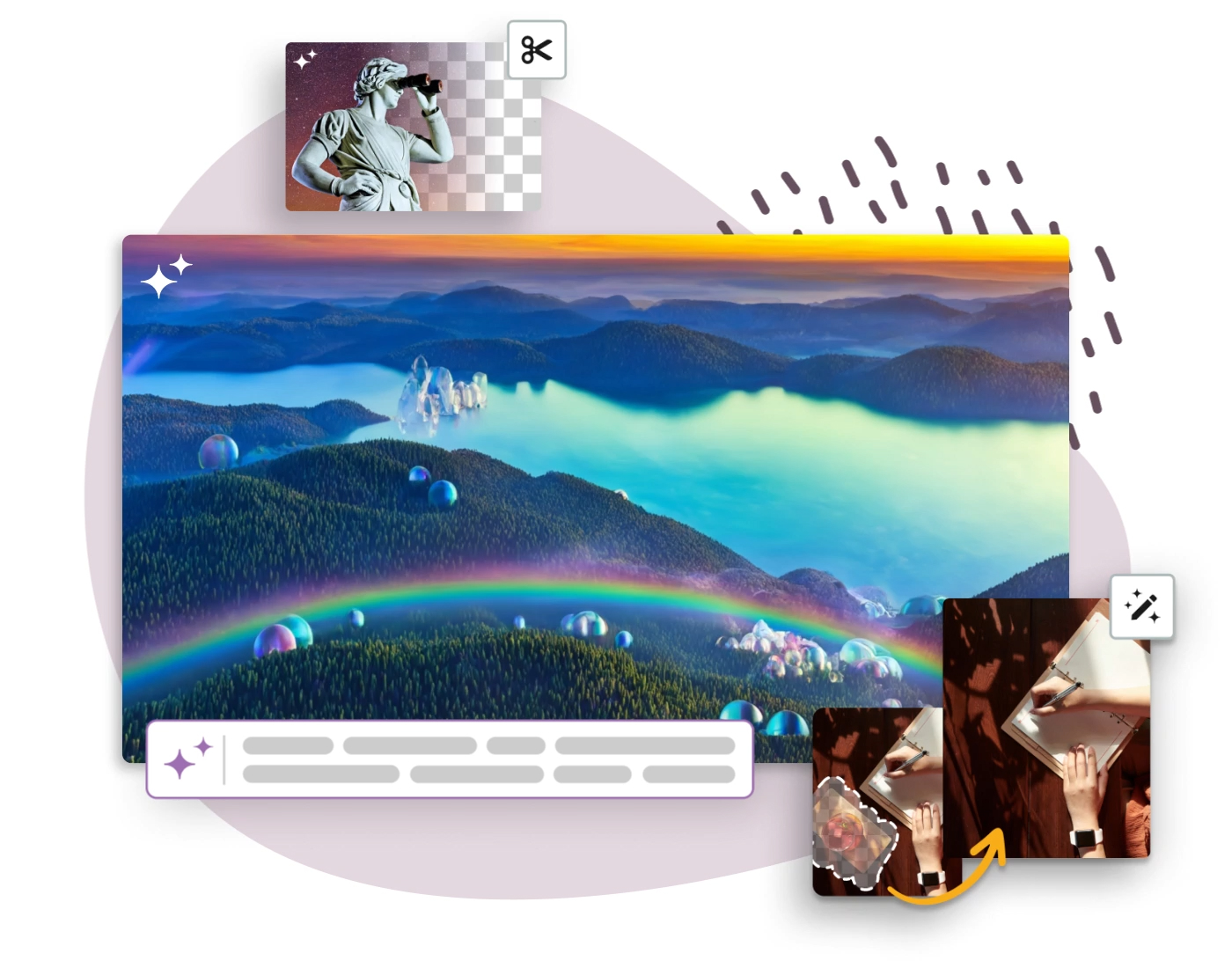How to write the perfect AI prompt: iStock’s 10 step guide to transform ideas into stunning images
iStock, a leading e-commerce platform for visual content, has unveiled a 10-step guide to help businesses master the craft of prompting for AI-generated images. The guide aims to assist SMBs and SMEs in leveraging AI for their visual content needs. Key steps include:
1. Ensuring commercial safety and legal protection
2. Starting with a clear vision
3. Being detailed and specific
4. Describing the scene's environment
5. Highlighting key elements
6. Incorporating emotions and mood
7. Including action or dynamics
8. Considering perspective and angle
9. Reviewing, refining, and iterating
10. Prioritizing authenticity
The guide emphasizes the importance of crafting effective prompts to transform ideas into stunning visuals using AI tools. It also highlights the need for transparency, as 90% of people want to know if an image is AI-generated, according to iStock's VisualGPS report.
iStock, una piattaforma leader nell'e-commerce per contenuti visivi, ha svelato una guida in 10 passaggi per aiutare le aziende a padroneggiare l'arte di creare richieste per immagini generate da IA. La guida mira ad assistere le PMI e le piccole imprese nell'utilizzare l'IA per le loro esigenze di contenuti visivi. I passaggi chiave includono:
1. Garantire sicurezza commerciale e protezione legale
2. Iniziare con una visione chiara
3. Essere dettagliati e specifici
4. Descrivere l'ambiente della scena
5. Sottolineare elementi chiave
6. Incorporare emozioni e umore
7. Includere azione o dinamica
8. Considerare prospettiva e angolo
9. Rivedere, affinare e iterare
10. Dare priorità all'autenticità
La guida sottolinea l'importanza di creare richieste efficaci per trasformare idee in visivi straordinari usando strumenti di IA. Mette anche in evidenza la necessità di trasparenza, poiché il 90% delle persone vuole sapere se un'immagine è generata dall'IA, secondo il rapporto VisualGPS di iStock.
iStock, una plataforma líder en comercio electrónico para contenido visual, ha revelado una guía de 10 pasos para ayudar a las empresas a dominar la habilidad de generar imágenes producidas por IA. La guía tiene como objetivo ayudar a las PYMEs a aprovechar la IA para sus necesidades de contenido visual. Los pasos clave incluyen:
1. Asegurar la seguridad comercial y la protección legal
2. Comenzar con una visión clara
3. Ser detallado y específico
4. Describir el entorno de la escena
5. Resaltar elementos clave
6. Incorporar emociones y atmósfera
7. Incluir acción o dinámica
8. Considerar perspectiva y ángulo
9. Revisar, refinar y repetir
10. Priorizar la autenticidad
La guía enfatiza la importancia de crear solicitudes efectivas para transformar ideas en visuales impresionantes utilizando herramientas de IA. También resalta la necesidad de transparencia, ya que el 90% de las personas quiere saber si una imagen fue generada por IA, según el informe VisualGPS de iStock.
iStock, 비주얼 콘텐츠를 위한 선두 전자상거래 플랫폼,은 AI 생성 이미지를 위한 프롬프트 작업을 마스터하는 데 도움이 되는 10단계 가이드를 공개했습니다. 이 가이드는 중소기업(SMB)과 중견기업(SME)이 비주얼 콘텐츠 요구를 위해 AI를 활용하는 것을 돕는 것을 목표로 합니다. 주요 단계는 다음과 같습니다:
1. 상업적 안전 및 법적 보호 보장
2. 명확한 비전으로 시작
3. 구체적이고 상세하게 설명
4. 장면의 환경 설명
5. 주요 요소 강조
6. 감정과 분위기 포함
7. 행동이나 동적 요소 포함
8. 시각적 관점과 각도 고려
9. 검토, 수정 및 반복
10. 진정성 우선시
가이드는 아이디어를 AI 도구를 사용하여 멋진 비주얼로 변형하는 데 효과적인 프롬프트를 작성하는 것의 중요성을 강조합니다. 또한, 90%의 사람들이 이미지가 AI 생성인지 알고 싶어한다고 언급하며 투명성의 필요성을 강조합니다. 이는 iStock의 VisualGPS 보고서에 따릅니다.
iStock, une plateforme de commerce électronique leader dans le domaine du contenu visuel, a dévoilé un guide en 10 étapes pour aider les entreprises à maîtriser l'art de la génération d'images produites par IA. Le guide a pour but d'assister les PME et TPE dans l'utilisation de l'IA pour leurs besoins en contenu visuel. Les étapes clés incluent :
1. Assurer la sécurité commerciale et la protection juridique
2. Commencer avec une vision claire
3. Être détaillé et spécifique
4. Décrire l'environnement de la scène
5. Mettre en avant les éléments clés
6. Incorporer des émotions et de l'ambiance
7. Inclure action ou dynamique
8. Considérer la perspective et l'angle
9. Réviser, affiner et itérer
10. Prioriser l'authenticité
Le guide insiste sur l'importance de créer des demandes efficaces pour transformer des idées en visuels époustouflants grâce aux outils d'IA. Il souligne également la nécessité de transparence, car 90 % des personnes souhaitent savoir si une image est générée par IA, selon le rapport VisualGPS d'iStock.
iStock, eine führende E-Commerce-Plattform für visuelle Inhalte, hat einen 10-Schritte-Leitfaden veröffentlicht, um Unternehmen dabei zu helfen, die Kunst des Erstellens von KI-generierten Bildern zu meistern. Der Leitfaden soll kleinen und mittelständischen Unternehmen (KMU) helfen, KI für ihre visuellen Inhaltsbedürfnisse zu nutzen. Zu den wichtigsten Schritten gehören:
1. Gewährleistung von gewerblichem Schutz und rechtlicher Absicherung
2. Klarheit über die Vision
3. Detailliert und spezifisch sein
4. Die Umgebung der Szene beschreiben
5. Wichtige Elemente hervorheben
6. Emotionen und Stimmung einbeziehen
7. Handlung oder Dynamik berücksichtigen
8. Perspektive und Winkel in Betracht ziehen
9. Überprüfen, Verfeinern und Iterieren
10. Authentizität priorisieren
Der Leitfaden betont die Bedeutung der Erstellung effektiver Aufforderungen, um Ideen mithilfe von KI-Tools in beeindruckende Visuals umzusetzen. Er hebt auch die Notwendigkeit von Transparenz hervor, da 90% der Menschen wissen möchten, ob ein Bild KI-generiert ist, wie im VisualGPS-Bericht von iStock angegeben.
- iStock launched an updated model for its commercially safe generative AI services and tools
- The guide provides businesses with a structured approach to create effective AI prompts
- AI-generated content offers SMBs and SMEs a way to unlock creative potential and streamline marketing efforts
- iStock's AI Generator allows for detailed prompts and advanced features like 4K generation capabilities
- None.
A Media Snippet accompanying this announcement is available by clicking on this link.
NEW YORK, Sept. 20, 2024 (GLOBE NEWSWIRE) -- As text to image generative AI continues to gain momentum, the ability to craft effective prompts—concise, creative instructions for AI tools—is emerging as a key advantage for businesses looking to leverage AI for their visual content. While AI generated images have opened new possibilities to create unique visuals, the difference between good and great often comes down to the tool but also – the prompt.
Building on the recent launch of an updated model for its commercially safe generative AI services and tools, iStock, a leading e-commerce platform offering images, videos and illustrations to small and medium sized businesses (SMBs) and enterprises (SMEs), today unveiled the ultimate 10-step guide to help businesses of all sizes master the craft of prompting.
“Prompts are at the core of AI-driven creativity,” says Bill Bon, Senior Director of Creative Operations at iStock. “The right prompt with the right tool can turn a simple idea into a powerful visual that truly captures your creative vision. It’s not just about what you want to see; it’s about understanding how to communicate that vision to the AI tool in a way that yields the best results and ultimately create the right image for what you need.”
For the right project, AI-generated content offers SMBs and SMEs a way to unlock creative potential, streamline marketing efforts, and create time efficiencies. To unlock these benefits, iStock experts share a 10-step guide to help anyone build compelling prompts and get the most out of text-to-image generative AI tools:
Step 1: Protect Your Creativity
First things first. Ensure that the generative AI tool you’re using produces images you can use in your marketing and advertising materials. This means, choosing a tool that is commercially safe and provides legal protection for your outputs. This safeguards you from creating something that may include elements that are legally protected. AI tools should amplify your creativity, not expose you to risk.
Step 2: Start with a Clear Vision
Begin by visualizing the scene you want to create. Think of a basic noun, verb, and setting/location, and then build out your prompt with adjectives and descriptive phrases. The clearer your initial concept, the better the AI tool will translate it into a compelling image.
Step 3: Be Detailed and Specific
Don’t hesitate to create longer, more descriptive, and complex prompts. Generative AI thrives on detail. Approach your prompts as if you’re telling a story, using comma-separated keywords to enhance your narrative. Also, tools like iStock’s AI Generator, with its recent model updates, allow you to be incredibly detailed and see how your desired features come to life thanks to advanced upscaling and increased 4K generation capabilities.
Step 4: Describe the Scene's Environment
Mention the setting where the scene takes place. For example, if you want an outdoor scene, specify if it’s in a forest, on a beach, or in an urban environment. Also, consider where your vision is located; after all, a “forest” in Brazil is hardly the same as one in Washington state.
Step 5: Highlight Key Elements
Identify the main subjects or focal points of the image. If it's a person, describe their appearance, clothing, and expression. For objects, focus on their size, shape, and placement. Experiment with language, even if you like the first image you generate. Try different words and phrases to see how they alter the outcome.
Step 6: Incorporate Emotions and Mood
Use aesthetic terms in your prompts to refine the overall look and feel of the image. Terms like "retro," "sharpened," or "monochrome" can guide the AI’s creative direction. Instructions like “vibrant colors,” “soft lighting,” or “moody atmosphere” can add a different style. If you're not sure which keywords to use, reference this extensive list of artistic keywords for AI image prompts. Also, consider adjusting parameters like color and mood filters to generate images with specific tones and feelings to align it to your vision.
Step 7: Include Action or Dynamics
If the scene involves movement or interaction, describe what’s happening. This could be as simple as "a cat playing with a ball of yarn" or "a city bustling with people." Descriptors like "future," "vintage," or "historical" can add layers of context to your output.
Step 8: Consider Perspective and Angle
Specify the viewpoint or angle from which the scene should be captured. This could be a bird’s-eye view, close-up, or wide shot, which influences the composition and framing. Refine your image by using camera controls, distinguishing lens type or depth of field, including wide angle, telephoto, shallow, or deep, to create the look of an image captured by a camera.
Step 9: Review, Refine and Iterate
Before finalizing your prompt, review it for any ambiguity or missing details. Use AI’s modification tools to tweak the visual further. You can add, replace, or remove elements from an image or expand or reduce the image ratio to fit the format you need. Even, when you are fully satisfied with an image, explore variations of that image and keep the active prompt text handy for future reference. Keep experimenting and iterating with your favorite prompts and other elements to spark fresh, bold ideas.
Step 10: Prioritize Authenticity
While AI tools offer incredible creative possibilities, it’s important to be authentic to your audience. iStock’s VisualGPS report revealed that a striking
With this guide, SMBs, SMEs and AI enthusiasts are now equipped to prompt more effectively, harnessing the power of generative AI tools to produce high-quality, impactful marketing visuals.
To get started and bring your prompts to life, watch this full video demo or visit https://www.istockphoto.com/en/ai, and start transforming your ideas with AI.
Media contact:
Ilse Noguez
https://www.globenewswire.com/NewsRoom/AttachmentNg/2980bf86-7282-4ea1-851d-d7103bda0d16









